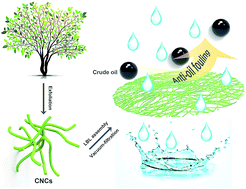Cellulose nanocrystals as anti-oil nanomaterials for separating crude oil from aqueous emulsions and mixtures†
Abstract
There is an increasing demand for anti-oil materials applicable in the efficient separation of crude oil from oil-in-water emulsions and oil/water mixtures for oily water treatment and oil spill remediation. Most of the reported superhydrophilic materials are able to repel model oils, but are still easy to be adsorbed and fouled by crude oil with high viscosity and strong adhesive properties. Herein, we report cellulose nanocrystals (CNCs) for fabricating nanopapers and nanocoatings with high anti-crude oil characteristics. These CNCs are composed of cellulose chains densely and rigidly arranged in a crystalline state, which rigorously restricts the motions of the hydrophilic groups on the material surfaces. They show more stable water binding affinity and lower underwater adhesive force than other super-hydrophilic materials. Therefore, the nanopapers and nano-coatings are capable of eliminating oil contamination from their surfaces not only in the water-wetted state, but also in the dry state. The nanopapers fabricated by vacuum-filtration can effectively separate surfactant-stabilized crude oil-in-water emulsions. The meshes assembled with nanocoatings are useful for the separation of crude oil/water mixtures with an extremely high water flux up to 35 000 L m−2 h−1. Meanwhile, the CNC-based nanomaterials show excellent anti-crude oil properties, no water flux decline, good pH stability and high salt resistance. All these characteristics make them potentially applicable to the remediation of crude oil spills on offshore seawater.



 Please wait while we load your content...
Please wait while we load your content...